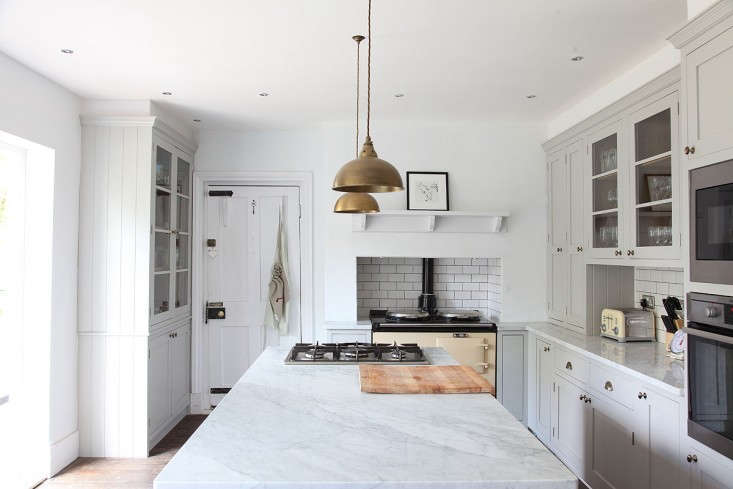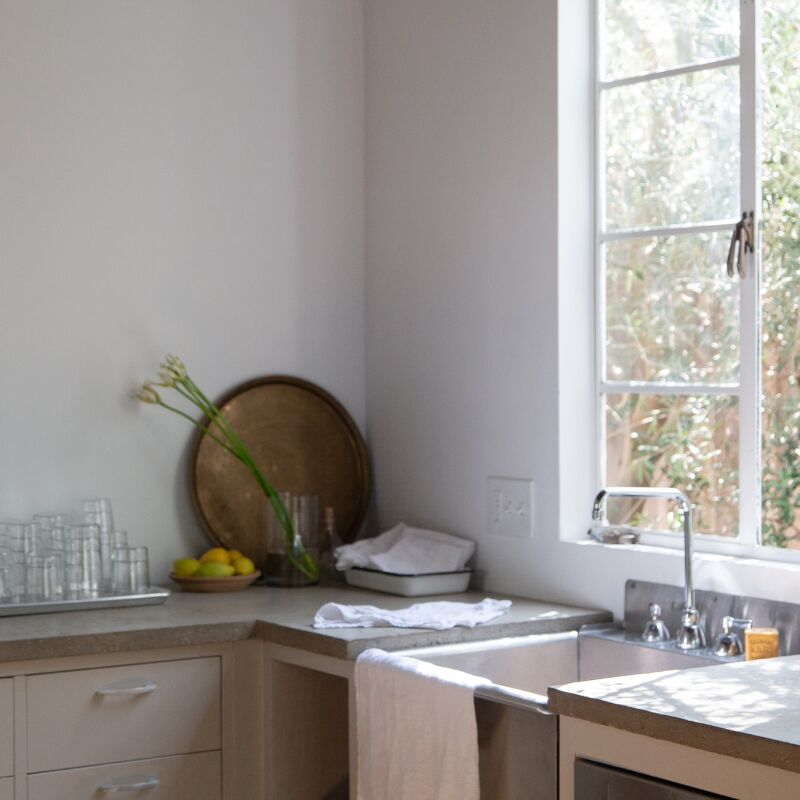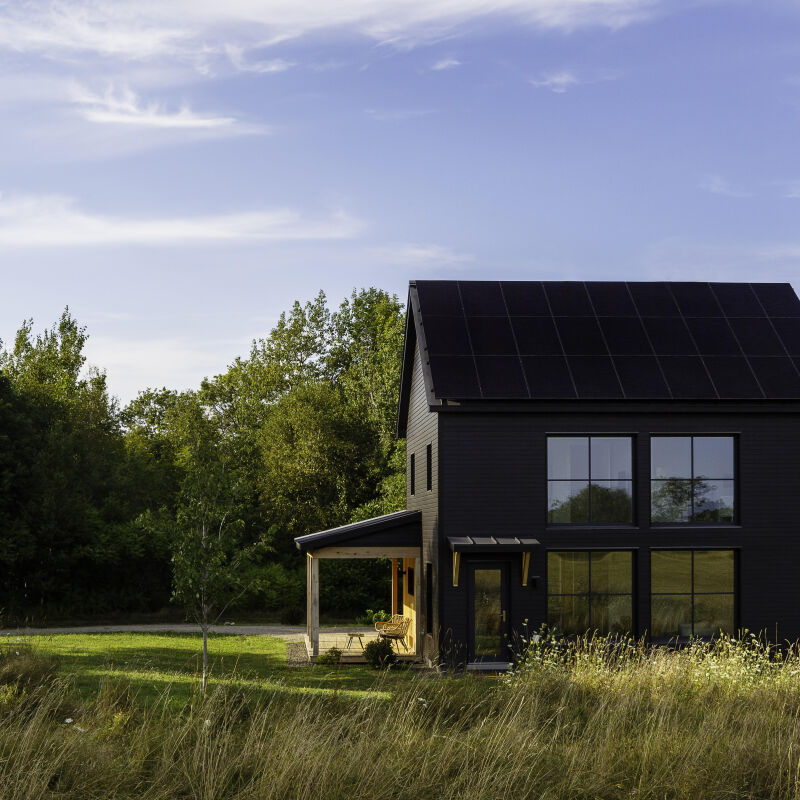Leaping (or lurching) into a kitchen remodel? If so, you’re likely about to make an important appliance decision: whether to install a range or a cooktop/wall oven combination.
The good and bad news is that the options in size, configurations, and cooking functions of ranges, cooktops, and ovens are vast. This allows for better adaptability to your cooking needs and your kitchen’s physical constraints. But it also makes the selection process complicated. Here are some key questions and tips from architects and designers to help you determine which cooking setup is best for you.
Made this decision recently? Please share your experiences in the comments section below.

What are your kitchen’s space constraints?
The consensus among experts is that a range is the best option for a small kitchen with limited wall and cabinet space. Ranges are straightforward in their space needs: They come in standard widths (generally 24, 30, 36, and 48 inches) and fit into a cabinet opening. Cooktops take up counter space but leave the base cabinet space available for storage. A single wall oven’s space needs are similar to a standard range and offer great flexibility of placement. It’s the double wall oven that’s the space hog—double ovens effectively remove 30 to 33 inches of usable countertop real estate.
How to decide which combination to go with? “The choice comes down to available square footage: A range usually takes up less space than a cooktop and a separate wall oven,” says Alison Davin of Bay Area–based Jute Home (a member of the Remodelista Architect and Designer Directory). “Our first priority in a kitchen is creating good flow: ample space for working, relaxing, and entertaining. It’s followed closely by storage. If these two boxes are checked and there’s room to spare, I love the functionality of a cooktop.”

Do you need one or two ovens?
How often do you use your cooking appliances and how much capacity do you need? Be realistic about how you cook. Try keeping a log for a few weeks to track how many times you use the stovetop and the oven. Julie Lacap, owner of Contractor’s Appliance Source in San Francisco, sees consumers often overestimating their need for an enormous oven. Call it the Thanksgiving turkey phenomenon. It can be a mistake to design the entire kitchen for that one annual meal.
- Are you an avid baker and don’t want to wait until your roasted vegetables are done before cooking the tart? Then a double oven setup might be in order.
- Do you entertain every weekend and have friends bring food that needs to be heated while your main course is in the oven? Sounds like a double oven–or a warming drawer–is needed. See our post Rediscovering the Warming Drawer.
- Do you have two ovens now and only use the second oven once a year for a family gathering? Consider making do with a single oven; as is, you’re losing valuable storage space the other 364 days a year.
Because ranges are generally limited (though not always) to one oven, wall ovens are the way to go if you need two full-sized ovens. Or, if you love ranges but need two ovens, consider supplementing with a single wall oven. If you’re short on wall space, it can be mounted in a base cabinet.

What are your cooking habits?
Your cooking habits also impact appliance choice:
- Do you tend to stand in front of your stovetop tending to your cooking? If so, you might want to avoid the heat radiating from an oven.
- Do you frequently transfer dishes from the stovetop to finish in the oven? Proximity is important in this case.
- How close do you want your pots and pans to your appliance?
- Do you have back issues? Hauling heavy pots out of a range oven can be burdensome. A wall oven at arm and eye height is likely a better choice for those with bad knees or backs. Be mindful, however, of wall oven placement in relation to your height. If the oven is placed too high, your forearms are at risk of getting burned, and reaching into the oven might not be possible, forcing you into an awkward spot at the side of the oven.
- Is burner configuration important to you? Cooktops offer more flexibility in burner style, size, and options like induction burners.

How many cooks are in your kitchen?
Here’s an instance where the number of cooks in the kitchen matters. If you’re a solo cook, then you don’t need to worry about competing for appliance access. If, however, it’s common for your kitchen to have two (or more) chefs operating side by side, it’s wise to consider a configuration that keeps you from getting in each other’s way. Using a cooktop and oven allows for the creation of separate cooking and baking zones.

Does your kitchen need a focal point?
“If a kitchen needs a focal point, use a range,” says San Francisco architect Mark Reilly, a member of the Remodelista Architect and Designer Directory. “It adds visual heft to a space and can act as the anchor when other features are lacking.” Alternatively, if a window, sink, view, and/or backsplash are the focal points, a cooktop is a good choice. It will let the other features stand out.

What are your aesthetic preferences?
Because there are so many options, the choice between a range and a cooktop/oven combo may come down to looks. Do you like the impact of a pro-style cooking setup? Then a range may be for you. Do you prefer the sleekness of built-ins? Wall ovens and a cooktop are the way to go. Even those who prefer the over-under setup of a range sometimes opt for a sleek fitting cooktop with a wall-oven mounted underneath.
Tip: Architect Mark Reilly, whose Belvedere kitchen remodel won the Remodelista 2013 Best Design Professional Kitchen Award, shares this trick: “Adding a stately hood over a cooktop can give it the heft of a range when a strong focal point is desired but a range won’t work.” Another tip: “When possible, center the range/cooktop on the kitchen space, island, and doorway. This helps organize the space and creates a strong visual connection between adjacent rooms.”
And the design team at Henrybuilt notes that a benefit of using a cooktop is that “the countertop line can carry across for a much more streamlined and linear look.” This is often an important consideration in setups where the kitchen and living areas blend together.

Are there significant cost differences?
The two cost factors are the appliance and the installation. Generally, ranges are the way to go to keep costs down. There more options at the lower end of the budget spectrum, and they’re also easy to install. That said, top-of the-line ranges are not more affordable than cooktop/oven combos. If you’re replacing existing units, it’s obviously less costly from an installation standpoint to stick with the same type of appliance. If you’re building a new kitchen, your options are varied.
Another cost consideration is replacement. If one cooking component of a range breaks, you have to replace both functioning parts (stovetop and oven). With a separate cooktop and oven setup, you can replace them individually. That said, separate cooktops and ovens vary in size from brand to brand and since they integrate closely with the adjacent cabinetry, you might have fewer options when it comes to replacement. Ranges are more standard in size and easy to replace.

Range vs. Cooktop/Oven Recap
Benefits of Ranges:
- All cooking functions are in one location
- A design statement good for kitchens needing a focal point
- Can be more affordable
- More space-efficient for small kitchens
- Easy to install
Benefits of Cooktop/Wall Oven Combos:
- Easier for multiple cooks
- Oven cooking can be more ergonomic: at eye and arm level
- Dual full-size oven capability
- Adaptability in kitchen configuration with separate cooking and baking zones
- Flexibility in cooktop configurations and sizes, and you can have different stovetop and oven widths
Coping with a compact kitchen? Get much more info via our Ranges & Ovens Resource Guide. Plus, see our posts:
- Remodeling 101: What to Know When Replacing Your Range
- Decoding BTUs: How Much Cooking Power Do You Really Need?
- 10 Easy Pieces: Retro Kitchen Ranges
- Remodeling 101: Beyond the Microwave, the Speed Oven
N.B.: This post is an update; the original story ran on May 1, 2014.
Frequently asked questions
What is the difference between a range and a cooktop and oven?
A range is a single appliance that combines a cooktop (the burners) and an oven in one unit. A cooktop and oven are separate appliances, with the cooktop installed on the countertop and the oven typically installed in a wall or base cabinet.
What are the advantages of a range?
The main advantage of a range is its compactness and space-saving design. It takes up less floor and countertop space compared to separate cooktops and ovens. Ranges are also generally easier to install and may be more cost-effective than purchasing and installing separate appliances.
What are the advantages of a cooktop and oven setup?
Opting for a cooktop and oven allows for more flexibility in kitchen design. You can choose different sizes and styles of cooktops and ovens that suit your specific needs and preferences. With separate units, you can also install the oven at an ergonomic height for easier access.
Which option is better for a small kitchen?
For small kitchens, a range is usually the more space-efficient choice. It combines the cooktop and oven into a single appliance, minimizing the footprint. However, if you have space to accommodate separate units and prefer a specific cooktop or oven style, a cooktop and oven setup can work well too.
Can I get the same features and performance with both options?
Both ranges and cooktops with ovens come in a variety of models with different features and performance levels. In general, you can find comparable options for both setups, including various burner configurations, oven capacities, and cooking functions. Consider your specific cooking needs and preferences when comparing features.
Can I mix different brands or models if I choose a cooktop and oven setup?
Yes, you can mix and match different brands or models when opting for a cooktop and oven setup. This allows you to choose the best appliances for each specific function. Just make sure to measure the available space and ensure compatibility between the units in terms of size, installation requirements, and fuel type.
Are there any installation considerations for a cooktop and oven setup?
Installing a cooktop and oven setup requires proper ventilation and electrical or gas connections. It's important to consult with a professional installer or electrician to ensure the installation meets safety codes and requirements. Consider the location of the cooktop and oven to facilitate convenient workflow in the kitchen.




Have a Question or Comment About This Post?
Join the conversation